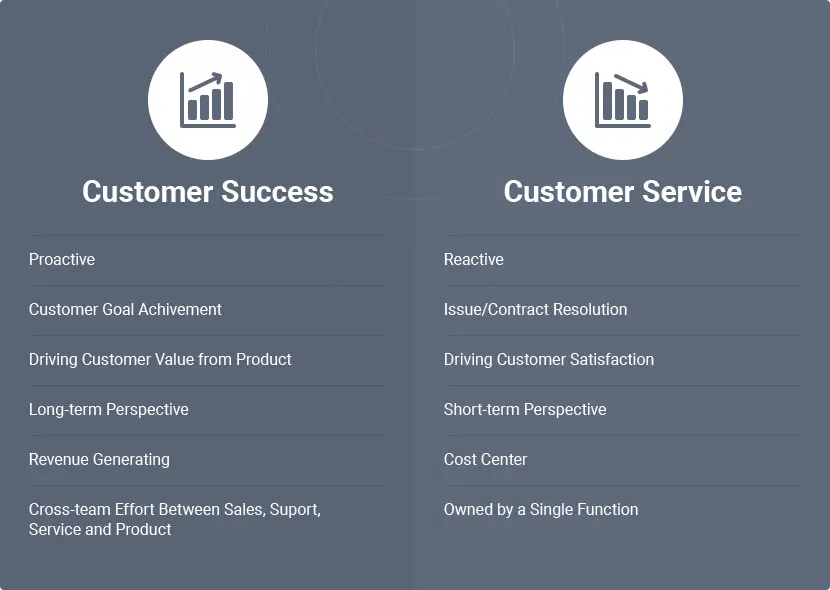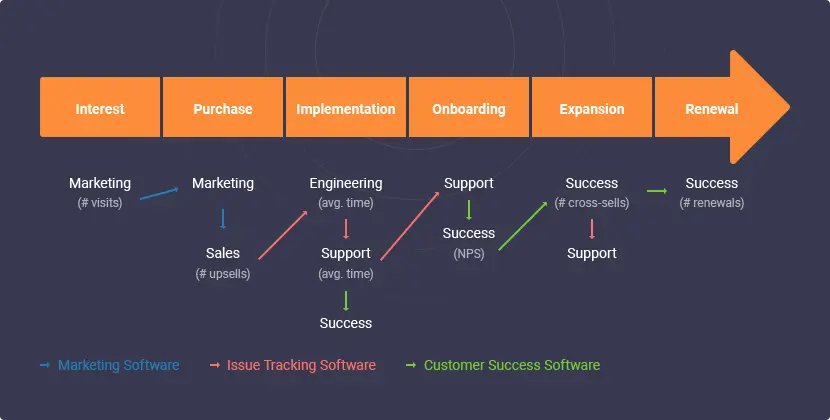Throughout my years in customer success, one key topic has always stood out. How does customer success differ from customer support?
In my experience, many people in business still struggle to understand the exact job of customer success. This has been the case for 20+ years since its start.
The confusion is so widespread. Last year, 56.3% of customer success managers (CSMs) said they did customer support. This number barely improved to 51.2% when we asked again this year for our CSM Insights report.
Today, let’s look at some clear insights. They show how a successful collaboration between customer success and support can work. But before that, I should go into why people are so confused.
Defining success and support
Customer success is a proactive business function. It is a department. It ensures that customers get value from a product. It does this through various tactics. These include:
- Onboarding optimization
- Proactive support
- Organizational goal-alignment
- Expansion and growth tactics
CSMs oversee account management. They ensure clients succeed with the company. And try to secure upsells or cross-sells, growing revenue.
On the other hand, customer support is a reactive business function in charge of customer service. Support agents oversee the ticketing system. They also oversee the customer feedback system. They step in to solve common customer issues or requests. They review feedback to decide what to pass up to the product team.
Main difference is in approach
Beyond other details, support and customer success teams differ fundamentally. One is proactive, the other is reactive. One focuses on customer goals. The other focuses on solving customer issues. Here’s a related side-by-side comparison.

So why the confusion?
I believe the main confusion between the two roles comes from the fact that CSMs are very good at service. Why? It’s simple. They know the account and all the common product or service issues. They are willing to help. In fact, the lead support agent often asks the account CSM for help. This happens when an issue is more hands-on or urgent.
I think that’s a good team-based way to keep service quality. But, only if it doesn’t disrupt the CSMs. But how does one ensure that? How do you make sure customer success management doesn’t become glorified support or yet another cost center? Where do you draw the line?
I am the founder and CEO of Custify, a customer success platform. This question has always been a balancing act for us and our customers. In what follows, I’ll go through some experience-backed tactics I’ve seen.
How customer support and success can work together
1. CSMs step in and help as needed/upon request
The best way to ensure effective collaboration is the one we’ve already mentioned:
- Support agents notice issues that are urgent, need more care, or happen often.
- Support managers decide which issues are important. They decide when to draw in the customer success leader for each account.
- CSMs step in and assist according to customer needs, while the support agent retains ownership.
- When an issue is more complex, they give it to the customer success manager.
This may look very different for your success or support team. The details depend on your business model, but the basic idea remains. Some issues are too complex. They are also too time-consuming for the customer support team. In such cases, a CSM helping is more effective.
2. CSMs ensure customer goal alignment and collaboration
CSMs ensure customer focus. They talk about what the customer wants. And they work on realizing value, onboarding, and advanced CS tactics.
CSMs have many tasks. But, I think the most important thing is aligning customers’ desired outcome. It’s also vital to foster collaboration.
How does that happen? It implies a series of steps involving nearly all of those teams.
- First, the head of CS makes a customer journey map. They work with all key stakeholders to ensure it captures the journey well.

- Next, CS ensures that everyone in the company has access to the map. They also ensure that all who work with customers, like customer support teams, read and grasp it.
- CS optimizes collaboration with other departments. This typically means:
- Customer support feels at ease working with CS. They work together on complex issues.
- A proper sales-to-CS handoff is in place. CS should have sales training from a sales rep.
- All customer-facing teams can work effectively with the product team.
- All the various cross-departmental software solutions and datasets are centralized.
- The customer success team also tells other teams about customer goals. It ensures they see them using the CS software. It also ensures they see the feedback. They use product feedback software or other tools set by the company.
This alignment can grow to be company-wide. But, the core should remain among support, success, sales, and product teams.
3. Support agents communicate issues up the chain
Collaboration goes both ways. Reps need to also feel comfortable pushing issues to the product or customer success team. They should do this in any of the following cases:
- When there’s a frequent feature request
- When a high-value or best-fit account has a complaint or request for a new feature
- When there’s a frequent issue customers raise to support
- When an issue becomes so complex it requires its own script
- When they don’t know how to solve an issue
- When it’s clear there’s a poor customer-product fit
Customer support must also do its part to ensure alignment. Some examples:
- Write down details about customers. Write down details about their customer interactions.
- They share any scripts they make. CSMs can use them if they run into the same issue while talking to customers.
- You will help CS recover lost accounts. You will also help them stop churn.
- Help CS personalize customer interactions. Do this whenever needed.
5. Both CS and support work together
32.4% of people who talk to customers think personalized messages are the right way to do it. This is from the State of Customer Messaging. They think it is closely followed by product and service improvements based on feedback, at 27.4%.
Smart integrations can help CS and support work together. They can optimize both. CSMs can review support information. Support can review CS information. This brings together the pieces of the puzzle: customer value realization.
How both teams measure their success
Customer support measures the quality and speed of resolution. This is a combination of quantitative and qualitative factors. The balance will be up to each and every company to decide. You can also set different goals depending on:
- The message channel. If the interactions happens via text, it should be graded differently from a call, for example.
- The type of customer. If the account is high touch and frequently shows up in the help center, then it makes sense to have longer calls.
- The goal of the interactions. Some interactions are meant to put out fires. Others are meant for customer education. Others still might be about advanced features. Each of these should be graded differently.
Customer success, however, has far more diverse and complex KPIs and metrics. Depending on the organization, the focus of the customer success leader can be:
- Preventing churn, ensuring customer retention, growing customer loyalty. CSMs who have this as a priority need early warning systems for at-risk customers. They also need to set up proactive measures. The quality and effectiveness of these is measured by the monthly, gross, and net recurring revenue (MRR, GRR, NRR). Most also keep an eye on churn rate.
- Securing expansion revenue. CSMs today need to be seen as more than a cost center. They are eager to prove their role as true revenue generators. The best way to achieve that is by using their sales skills to get upsells, cross-sells, or feature additions. The number of upgrades is a good performance metric. So is the expansion revenue they bring.
- Increasing customer lifetime value. Lifetime value (LTV or CLTV) is one of the key metrics in CS. It’s often put together with customer acquisition cost (CAC), turning into the LTV:CAC ratio – a metric many use as a north star. By focusing on it, CSMs have to do everything in their power to grow their accounts. This includes upsells, churn reduction, and more.
- Facilitating customer value. Companies that are smarter or more complex will reframe digital customer success to focus on customer value. After all, a customer that sees the value becomes loyal and is more likely to upgrade. The best way to track this is through a metric called Time to Value (TTV). Customers who get adequate training and customer onboarding reach this value sooner. Customer success must be able to track that.
All in all, you can see that success and support differ when it comes to measuring their performance.
Looking at customer success vs satisfaction vs experience
Many business people are even more confused. They don’t understand the difference. Customer success is not the same as customer experience. Even more confusing, there’s also customer satisfaction. Why do we need so many terms for more or less the same thing?
I tend to agree. However, let’s put it to rest with a few simple definitions:
- CSAT measures how satisfied customers are. You measure it through a survey. It’s often used in conjunction with the Net promoter score (NPS).
- Customer experience, aka CX, is used as a blanket term for the entire experience a customer has with your business. This can be experience with the product, services, or people within your organization.
- Both CSAT and CX are part of customer success in a way. CSAT is a tool that the success team uses. CX is something they oversee.
Closing the gap between success and support
The gap between customer success and support doesn’t need to be a roadblock to your success.
It can be a bridge and an opportunity. It’s a path for both teams to work together. They can work towards the goal of pleasing customers. They can also work to grow the organization. Your growth will last only if the whole company’s cogs work together well. It all starts and ends with your customers’ success.





